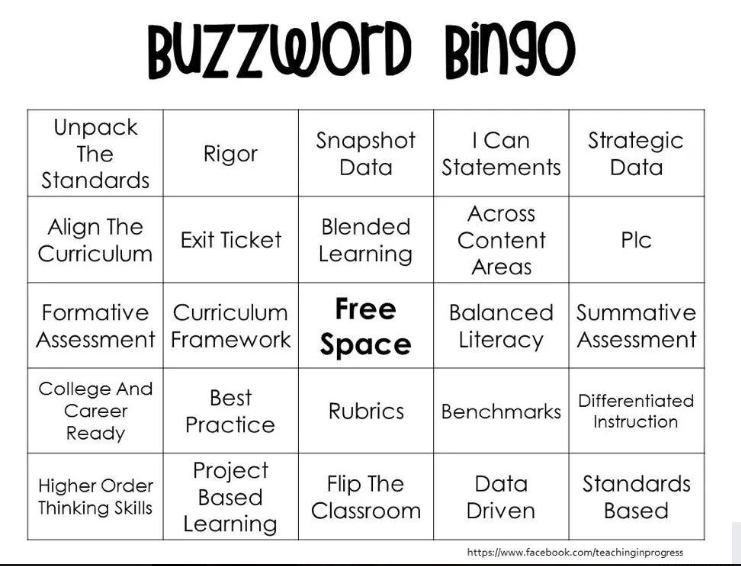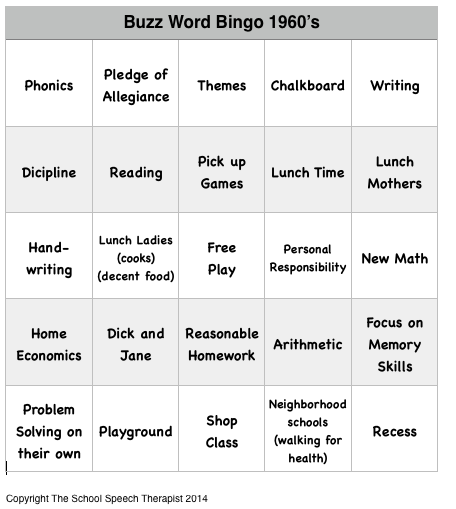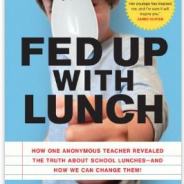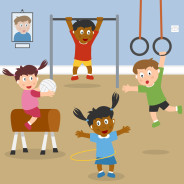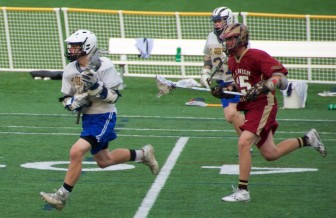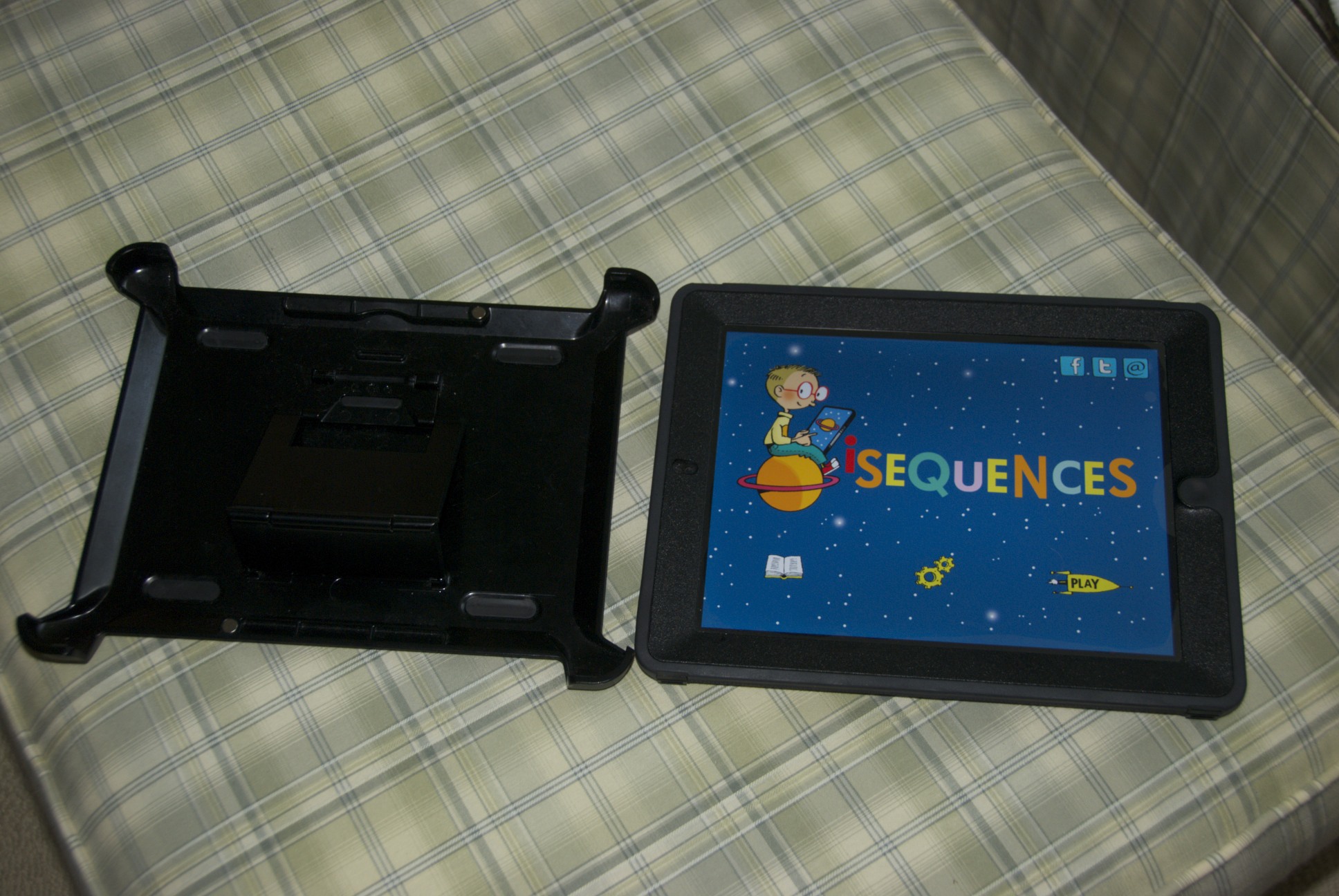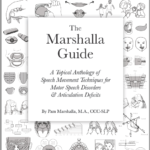Parent Information
This page is designed for parents who have questions about the child’s speech and language development. Please visit my other pages too, especially Your Middle Schooler even if your child is years away from the tween years. Please contact me if you have any specific questions or need information in any specific area of speech and language development.
Teresa
Have a good chuckle but think while you’re laughing
A few weeks ago I saw this “Buzz Word Bingo Card” floating around Facebook. So much of this buzz word bingo had to do with measuring what students have learned rather than how/what students are being taught. I assumed that that was why it made it on some of the funny education and anti-common core pages. Does any buzz word here actually tell you anything about what the students are learning? I’ll let you generate your own opinion on that. Now compare this buzz word bingo card to the one below.
Here is the Buzz Word Bingo that teachers might have shared in the late 1960’s. Granted someone would have had to recreate it and run it off on on mimeograph machine (which were still used until the early 80ies). It is important to note that using the Buzz Words from the 1960’s, many children received a good solid foundational education. Was it perfect? No. Was awareness yet heightened around learning and language disabilities? NO! However, the good teachers who did not have bulging classrooms did try their best to help all children succeed. I know there was more teaching and less measuring. I know many of you may have hated Dick and Jane but guess what the formula worked for a variety of children, giving them not only reading success but self confidence to read. My favorite three on the Buzz Word Bingo 1960 are PHONICS, HANDWRITING and FOCUS ON MEMORY SKILLS.
Thanksgiving Humor
I found these Thanksgiving themed jokes floating around Facebook this week. Even though it’s after Thanksgiving I am going to use these (or some of these) in therapy this week. I believe they’re still relevant because the students just experienced Thanksgiving and with any luck remembered some of the details. I am big on teaching how to recognize and understand humor. Understanding humor is a huge part of social pragmatics. I often have an objective focusing on humor written into my student’s ed plans.
If students can’t “get it” they are often left behind both within the social realm and as curriculum/materials becomes more challenging. Subtleties in language are all around us, from tv to textbooks. Some kids “get it” easily and naturally and some do not. Most of our language disabled kids need a lot of help learning how to “get it”.
15 Thanksgiving Jokes
- What happened when the turkey got into a fight?
He got the stuffing knocked out of him. - What did the baby corn say to the mama corn?
Where’s the popcorn? - Why did the police arrest the turkey?
He was suspected of fowl play. - What are unhappy cranberries called?
Blue Berries. - What sound does a turkey phone make?
Wing! Wing! - What kind of car would a pilgrim drive?
A Plymouth. - What is a turkey’s favorite dessert?
A Peach Gobbler. - When does Christmas come before Thanksgiving?
In the dictionary! - How does a turkey drink her wine?
With a gobble-let. - Why did the cranberries turn red?
Because they saw the turkey dressing. - What do turkeys use to clean themselves?
A feather duster. - Why did the pie go to the dentist?
Because it needed a filling. - What kind of music did pilgrims listen to at the first Thanksgiving?
Plymouth Rock - Why do potatoes make good detectives?
They keep their eyes peeled. - How many cooks does it take to stuff a turkey?
One, but you really have to squeeze him in.
Originally compiled by Michelle Regna BuzzFeed Staff
http://www.buzzfeed.com/michelleregna/15-thanksgiving-jokes-your-grandma-will-eat-up
Professional Liability Insurance for SLPs
Shopping on Amazon this Season
With Cyber Monday beginning for some probably today, if you order from Amazon remember to order through your favorite blog (such as mine) Look for the Amazon link on the site and order from there. Or sign up for Amazon smile and send a few pennies to your favorite charity. It truly is only pennies but every little bit adds up. Since I can’t order through my own blog, I support the Trustees of Reservations.
Osmo-I do like this new product!
Over the summer I was inundated with ads from a new educational product called Osmo. It’s basically a very unique app that works with your iPad and incorporates manipulative. After seeing the demo video I was hooked and I had to have one. Mine arrived this week.
The special edition pack came with 2 sets of game manipulatives, Tanagram and Words. A third game called Newton was available for download (using the manipulatives of a paper and pencil or any solid object, including your hands). What puts a different spin on the Tanagram game is that the child has to shift their eye gaze from table to iPad to complete the tasks rather than lay an tanagram on top of a copy. It’s a fairly simple task but for young children or those with learning issues it is wonderful practice. As a therapist, I would love to see Tanagram leveled and expanded down the road.
Word comes with scrabble like pieces and you have to complete a variety of leveled word completion tasks. Pictures are presented, some with letter clues and some without. It’s a little like hangman. You can download and use pictures in a variety of categories. Being able to break the pictures down into specific categories is a big plus for me as a therapist. The most challenging level was somewhat abstract, with a few words/places we had not even heard of but that did make it fun for us.
Newton is difficult to describe. It’s like a pinball game where you have to hit targets, only you are trying to figure out the path to the target. You’re creating the path using pen/paper or other items to create the path, allowing the balls to bounce off and hit the target, while watching it on the screen. Again practicing that eye shift skill.
I tried the Osmo games with a couple of my students yesterday and they both loved them. Both the Tanagram and Word games focused on practicing some of their weak underlying learning skills. It didn’t move too fast for them. Since they really don’t need to touch the iPad while using it, inaccuracy often experienced when hitting the iPad was almost a non-issue.
The one drawback to this first edition of Osmo is that you have to remove the iPad from its case before it can be used. Personally I won’t let my students near the iPad unless it is encased in my Otter Box. Most schools are protecting their electronics with similar sturdy cases. I mentioned this to the company early on, they know it is an issue and are working on it. However, I was so excited with the technology and possible applications I was willing to try it knowing I would have to unearth my iPad from it’s case. At this point it will keep me from using Osmo with certain students and as often as I would like.
My mind has been swimming with ideas on different apps Osmo developers could create to target speech and language, occupational therapy and educational needs. I believe the possibilities are endless. In this day and age where second graders are now issued iPads and preschoolers are put in front of the iPad instead of the tv, adding manipulative to the iPad experience will help to create a more traditional and developmentally appropriate learning experience. I am so looking forward to the development of new applications for education, speech and language development and just for fun.
55 Movies Every Kid Should See and Talk About (before they’re 13)
As a speech language pathologist I always look for fun ways to encourage language development. No matter what I am looking at or reading, my mind is always thinking about how I can present or modify the information/activity to benefit my students (or my own kids). This week I read an article in Entertainment Weekly titled “The 55 Essential Movies Kids Must Experience (Before They Turn 13).” Then I noticed my own young adult children joking with each other by quoting lines from TV/movies or talking about characteristics of memorable characters. Sometime these conversations go deeper discussing the music used in movies, the historical relevance/mistakes, continuity/goofs and trivia.
There is a lot of language that can be learned from TV and Movies. Think about some of the animated Disney or Pixar films that constantly use play on words and sarcasm. Many of these movies have over dramatized scenes that get the humor or point across. These movies pair fun visuals with novel language and kids pick it up. The novel language is also presented in context, making it easier for kids to figure out. They also benefit from hearing the appropriate intonation or sarcastic tone. With video streaming watching a movie more than once is the norm so kids hear movie language over and over.
Use this list of the “The 55 Essential Movies Kids Must Experience (Before They Turn 13)” as a guide to choosing a movie some night when you can’t find anything good on tv. Note that many of these movies are a little old or are based on books. That doesn’t make them any less valuable language wise.
Even though I’ve always personally been drawn to tv and movies, I still recommend reading the book before seeing the movie. Reading will stimulate and help to develop kids inner visualization and visualization is key to language comprehension and critical thinking. Discussing differences between books and movies can also be a lot of fun
Watch movies together once in awhile and after the movie, talk about it. Ask questions beyond “Did you like it?”, quote the lines from the movie once in awhile, sing songs from the movie and bring up movie scenes when they might relate to something currently going on in your child’s life.
This list of 55 in not totally comprehensive. There are a lot of good movies for children and especially tweens that will broaden their language skill and make them think. What movies would you add to this list and for what age level?
Amazon Prime makes it easy to find and stream movies, some free some not. If you shop Amazon a lot, Prime ends up paying for itself.
Fed Up With Lunch – Book Review
Book Review
“Fed Up With Lunch”
By Author: Sarah Wu
As a 30 year veteran of the public school system, I can tell you honestly that I haven’t voluntarily eaten a school lunch since 1983. I won’t go into the gory detail but lets just say that the meal of pulled BBQ pork just didn’t sit well. I’ve worked in many school systems and have witnessed many attempts to upgrade school lunch programs. These changes included hiring a new person to run the school lunch program, new schools with elaborate cafeterias, bringing in an outside service to run the food program, salad bars, menus with fun upbeat names and finally the worse going from a lunch lady who actually cooked the food to a service that provided styrofoam trays pre-filled with extremely small portions of reheated food (I guess that saved money). Despite these attempts to improve school lunch, to me the lunches always looked like the same crap food served in a different way.
As you can tell I have a total distain for school lunch programs so when a related search turned up Sarah Wu’s book “Fed Up With Lunch,” I knew it was a must read.
“Fed Up With Lunch” is based on Sarah Wu’s experiment and original blog. She vowed to eat a school lunch everyday for a year and blog about it. In the process she observed a few disturbing secrets about school food programs. Some of Mrs. Wu’s research involved looking at the ingredients in school food, analyzing menus, what actually passes for nutritional requirements, lack of fresh food, over packaging/processing and where some of the food comes from. Her school lunch journey has taken Mrs. Wu from blogging anonymously as Mrs. Q to appearances on various national panels to this book.
Along with talking about “the food” in school lunch programs. Mrs Wu also delves into the fact that children are rushed through meals at school and have little or no opportunity to move through the day. This is what I have personally observed in every public school I have ever worked in. Mrs. Wu was also careful to point out that Lunch Ladies are not cooks anymore but servers. Yet what they are given to serve often reflects badly on them when what to serve is usually an administrative decision.
Mrs. Wu’s book goes just short of criticizing government policies, Michelle Obama’s Lets Move program or school administrators. In her book she chooses to take a more active approach by suggesting her own ideas for positive change and providing several suggestions on what parents, teachers and students can do to improve their school lunch programs.
This was an informative and well organized book. Reading it should make any parent, teacher and school administrator think twice about what school are serving and what their kids are eating. I find it ironic that just about every school in America has alined themselves with the government sponsored wellness program, but yet the food served in schools in the United States has not improved one bit and physical exercise is not strongly encouraged. Under the new wellness programs in schools, I can’t give a hungry student a granola bar or even an apple but school cafeteria still serve grey green beans, mystery meat or tater tots several times a week. The amount of food thrown away on any given school day in any school I’ve ever worked in is astounding. Parents have no way of knowing what or if their kids are eating unless they make a concerted effort to ask or occasionally observe. Apparently in some school districts, bringing a lunch from home is not even an option.
I loved the idea of Mrs. Wu’s project and enjoyed reading about her experiences. It made me think, perhaps school food would be better if all the administrators were required to eat school lunches or not allowed to bring lunches from home. Wouldn’t it be interesting if the food served to the kids at lunch was also served at school functions and administrative meetings, styrofoam trays and all. Something tells me food services would improve greatly. Any administrators or districts that want to take on that challenge?
Lets be realistic about school wellness programs…then maybe they’ll work
Last week a friend sent me another article on Michelle Obama’s Lets Move Campaign. The article focused a new policies where “unhealthy foods” would not allow to be advertised during the school day. In particular the article referred to the advertising of certain CocaCola company products not being allowed in schools. Keep in mind how much support the Coca-Cola company has given to many causes over the years, especially the Olympics.
“The idea here is simple – our classrooms should be healthy places where kids aren’t bombarded with ads for junk food,” the first lady said. “Because when parents are working hard to teach their kids healthy habits at home, their work shouldn’t be undone by unhealthy messages at school.” M. Obama
I am a little perplexed by what Mrs. Obama is trying to do. I’ve worked in schools for almost 30 years. I’ve never seen junk food advertising in any classroom. I haven’t seen a soda machine in schools for years. It seems as though she is trying to accomplish something that common sense dictated years ago. I’ve never seen advertising of any kind other than occasional vending machines in any school at any time. So basically Mrs. Obama is trying to achieve something that was initiated and successfully addressed at least 20 years ago. It’s also seems contradictory that advertising of “diet” drinks are going to be allowed. Personally I think the chemicals in diet drinks are even less healthy for children. Mrs. Obama, should we be promoting diet drinks to our school children?
I agree with the basic premise of Mrs. Obama’s Lets Move Campaign. When I look around any school I see many more kids that are heavier than they should be. But she is really missing the mark going after the large companies to decreasing their advertising basically because few actually advertise in schools and none on a large scale basis. Mrs. Obama should look at the name of her campaign and focus on getting kids moving. Schools can modify their schedules to extend recess, spend more time outside, make lunch more relaxing (and social) and provide better school lunches. Why focus on taking away something that is hardly there.
If Lets Move wants to support better nutrition in general, it should start a little closer to home. I’d like to know if Michelle Obama has ever seen or eaten a public school lunch? It’s been my experience to see, small portions served on cardboard or styrofoam trays, food that has been in a warmer for hours (yes hours), unappealing choices, mushy or dehydrated food and frankly poor quality food. Food programs at most schools have switched over from having school cooks to food services where the cooked food is shipped in and kept in warmers. Peek in any trash barrel in any school cafeteria and you will see just how much of “school food” is thrown out. When this much food it inedible or unappealing and not consumed, children have to be starving by the end of the school day. This can’t be good for blood sugar levels.
So how much are kids actually moving in a typical school day? This is going to vary from school to school. It’s been my experience that students have anywhere from 30-40 minutes to shove in their lunch wait for everyone to finish and then run out side to play for 15 or so minutes. Schools rarely provide playground equipment and frankly most kids don’t know how to organize games anymore. Recess is usually inconsistent lasting 15-30 minutes at most. Middle schoolers rarely get recess at all. In the winter time students in cold climates are at times confined to their classroom the whole day. Physical education classes meet for an hour once or twice a week. It’s also important to note that even if schools or principals want to increase their students movement time, the demands of Common Core puts significant limits on time allotted for recess and physical education.
How many exercise opportunities do children have outside the school day? Schools have so much to cover that even with the best intentions, schools can teach healthy habits but cannot provide adequate opportunities to exercise. Perhaps Mrs. Obama’s program should put more effort into developing opportunities to exercise outside of the school day and encouraging parents to take advantage of those opportunities. Instead of alienating large corporations such as Coca-Cola use them to help fund new exercise, sports or dance programs. Children especially from less affluent communities have fewer opportunities to join organized teams, exercise programs or lessons.
Children from all socioeconomic levels are spending an inordinate amount of time playing video games. This is hard to believe but some students actually believe they are playing sports when playing video games. Children are now being raised by video gamers and instead of shooting hoops in the backyard, parents and children now play video games together. If they’re playing video games they are usually not getting much exercise. Perhaps if Michelle Obama and Let’s Move is so adamant about going after corporations that produced less than nutritious food then perhaps they should also go after video game manufacturers since video games keep kids from moving. An awful lot of computer games are used in schools too, some with little to no educational value.
Let’s Move has been in place for 4 years now and other than absurd wellness programs that have infiltrated schools I haven’t seen many changes in students physical well being. These wellness programs have sucked all the fun out of any school celebration since no treats of any kind are allowed. Basically you can’t give a hungry kid a granola bar anymore. Even students who have yearly physicals are being weighed at school and told they are fat in very public ways. And to top it off school lunches are still awful. It’s time to be a little more realistic when it comes to developing wellness programs in schools. Mrs. Obama should put some initiatives together that are realistic, actually have a chance to be successful and might accomplish something.
Setting examples for good nutrition and exercise in schools:
- Provide nutritious and appealing meals for school lunches
- Have school lunches prepared at schools and use locally grown veggies and fruits whenever possible
- Build in more time for a relaxing meal
- Don’t have kids eat where they work even at snack time
- Allow wellness plans some flexibility, reasonable treats should be allowed on special occasions.
- Allow more time for recess, provide typical playground equipment and teach students how to organize typical playground games.
- Allow longer and flexible breaks after lunch especially for older students where they have some choice on how they manage their time
- Provide physical education classes at least 2-3 days a week, rather than focus on playing games, teach underlying skills, traditional and other types of exercises, how to organize games and provide cardio workouts.
- Provide an outdoor recess whenever possible.
- Encourage students to participate in community based opportunities to exercise, play organized sports or take lessons such as dance or gymnastics.
Play skills are even more important than you think
Several years ago I wrote an article on the importance of play. My slant on the article was more about the importance of learning (or lack of learning) social skills, initiation of interactions and negotiation during play. This week I noted a topic hitting the educational sites on the internet about kids doing better when they get more exercise. The articles were based on a Canadian study called “School-Based Health Promotion and Physical Activity During and After School Hours” that was published in Pediatrics Journal. Now the study itself isn’t that eye opening. It basically states that the school initiatives to promote better health in Canada has worked to get kids moving both in and out of school. All I can say is that it is just too bad that time and money is wasted on something that parents, teachers, doctors and just about anyone else on the planet has known for years. Exercise and other physical activity is good for kids. But in this world of data, data, data it is good press.
In my article “Play skills are more important than you think” I stated,
“If you think kids are getting an opportunity to play at school, think again. Recess and lunch recess is 15 minutes at best these days. Hardly enough time to organize and play anything. Once kids get to middle school, there may be no recess or lunch recess.”
Over my almost 50 years as a student and a teacher, I’ve seen lunch time shrink, lunch recess shrink, extra outdoor recess go away, every free moment disappear from the classroom and gym/art/music cut back (significantly). I’ve also seen the amount of snacking increase, over processed foods sent in for lunch and school lunches reduced to dehydrated unappealing muck served on styrofoam trays that could hardly be called a meal (and quite a bit of it ends up in the trash FYI). With all the school health initiatives here in the United States, all fun activities and celebrations are now food free. Talk about sucking the fun out of everything but that’s a topic for another article.
There was a time when kids were given enough time to eat and play during lunch. Lunch Ladies would make sure you ate what your mom sent in or what you got on your tray but you managed your own time. When you were done eating you could go out. Very few school had play structures, so kids spent their time usually on the black top (parking lot). Guess what, in some schools not everyone stayed for lunch. Students who lived close to school had time to walk home, eat lunch, watch a little tv and walk back to school. Both these scenarios gave students choices and taught students how managed their time from an early age.
Lunch recess lasted as long as an hour in some cases. Kids returning from their home lunch experience would often join in. Rarely did you see a kid standing around doing nothing. Schools provided a variety of simple playground equipment balls, chalk to draw a 4 square and jump ropes. Students could be counted on to organize kickball games, dodgeball games, 4 square games and handball games. Today it is a little pathetic to watch recess because kids don’t know how to organize games and many float around the play area not knowing what to do.
Do kids return to the classroom better able to focus and learn after a longer play time? I would assume so but of course I don’t have any data on that. What I do know for a fact is that kids were thinner and probably in better shape. I know where I grew up not too many kids were taking dance or gymnastics. Organized sports didn’t start until about 6 grade so the exercise we got was from playing. We played at school and we played in the neighborhood. We slurped down regular Coke and Pepsi like water. There was a candy store on every corner and we all indulged. There were several ice cream venues and the good humor man came by regularly. How did we stay so thin, exercise. What a surprise, movement and activity kept us thin. We didn’t even know it was exercise!
What schools could do:
Bring back the cooks and have meals actually prepared at the school.
Add more lunch room attendants so kids can go out when they are finished eating
Provide longer lunch times in general
Add extra recess, especially in warmer weather
Provide appropriate play equipment that must be taken care of and shared
Consult with the physical education teachers on how to teach kids the art of organizing games
Hire lunch room attendants who will encourage students to organize games.
Teresa
Related Articles Kids Improve with School-Based Physical Activity Interventions By: NeuroNet StudentsWho Lose Recess Are the Ones Who Need It Most By JESSICA LAHEY
NSSLHA at Assumption College Raising Awareness around Noise Induced Hearing Loss
This semester I have begun my journey in an Introduction to Audiology course. We have learned about a variety of forms of hearing loss and there is one that really stands out to me. This is Noise Induced Hearing Loss. This has become much more relevant with the increased use of ear buds. As many of you know, May is Better Speech and Hearing Month. At Assumption College, there is an annual spring concert in the beginning of May. The NSSLHA chapter at Assumption College has taken on the responsibility of spreading awareness of noise induced hearing loss around campus. We provide ear plugs for students and suggest that they wear them to the upcoming concert. This has become an important event for us on campus.
It is important that people know the damage that can be done when they expose themselves to noises over 85 dBs. Noise induced hearing loss is a sensorineural hearing loss. This means that there is dysfunction of the cochlea or auditory nerve. More specifically, noise induced hearing loss creates damage to the outer hair cells that line the cochlea. This can cause a hearing loss up to 120 dBs, which is a pretty significant hearing loss. It is important that people take certain precautions to prevent this damage. Some of the precautions that are recommended to people are to lower the volume on personal ear buds and to take occasional breaks when using ear buds. Using these precautions can help preserve ones hearing and reduce the risk of having noise induced hearing loss.
With all of the new technology that exists in our world today, people should know what the damage can be when these technologies are wrongly used. With Better Speech and Hearing Month, as well as our school concert quickly approaching, it is important for the NSSLHA chapter at Assumption College to spread awareness of Noise Induced Hearing Loss. Everyone should encourage these small changes and promote healthy hearing!
Use your earbuds wisely.
The School Speech Therapist
NSSLHA stands for the National Student Speech Language and Hearing Association. The college student equivalent of ASHA The American Speech Hearing and Language Association.
Otterbox is still the way to go…When using electronics with kids
Back in July I wrote an article on Protecting Your Electronics. I strongly suggested an Otterbox case for iPads, when working with children. I’ve used this case for almost a year and other than it being a little big and bulky, I am still very pleased with it.
A couple of weeks ago needed to contact Otterbox customer service because the stand up holder inside the removable top broke. I was still able to use it but it wouldn’t always stay in place. I believe I broke it not one of my students. I filled out a form on line and provided them with a picture of the broken piece. Within a week or so I had a new top for my iPad Otterbox case.
The procedure was simple, Otterbox kept in contact with me and the replacement part arrived on time. Next time I need a case for anything, I’ll be looking for an Otterbox.
Now they all come in such fun colors!

